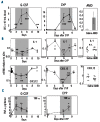B-lymphopoiesis is stopped by mobilizing doses of G-CSF and is rescued by overexpression of the anti-apoptotic protein Bcl2
- PMID: 22929978
- PMCID: PMC3659924
- DOI: 10.3324/haematol.2012.069260
B-lymphopoiesis is stopped by mobilizing doses of G-CSF and is rescued by overexpression of the anti-apoptotic protein Bcl2
Abstract
Osteoblasts are necessary to B lymphopoiesis and mobilizing doses of G-CSF or cyclophosphamide inhibit osteoblasts, whereas AMD3100/Plerixafor does not. However, the effect of these mobilizing agents on B lymphopoiesis has not been reported. Mice (wild-type, knocked-out for TNF-α and TRAIL, or over-expressing Bcl-2) were mobilized with G-CSF, cyclophosphamide, or AMD3100. Bone marrow, blood, spleen and lymph node content in B cells was measured. G-CSF stopped medullar B lymphopoiesis with concomitant loss of B-cell colony-forming units, pre-pro-B, pro-B, pre-B and mature B cells and increased B-cell apoptosis by an indirect mechanism. Overexpression of the anti-apoptotic protein Bcl2 in transgenic mice rescued B-cell colony forming units and pre-pro-B cells in the marrow, and prevented loss of all B cells in marrow, blood and spleen. Blockade of endogenous soluble TNF-α with Etanercept, or combined deletion of the TNF-α and TRAIL genes did not prevent B lymphopoiesis arrest in response to G-CSF. Unlike G-CSF, treatments with cyclophosphamide or AMD3100 did not suppress B lymphopoiesis but caused instead robust B-cell mobilization. G-CSF, cyclophosphamide and AMD3100 have distinct effects on B lymphopoiesis and B-cell mobilization with: 1) G-CSF inhibiting medullar B lymphopoiesis without mobilizing B cells in a mechanism distinct from the TNF-α-mediated loss of B lymphopoiesis observed during inflammation or viral infections; 2) CYP mobilizing B cells but blocking their maturation; and 3) AMD3100 mobilizing B cells without affecting B lymphopoiesis. These results suggest that blood mobilized with these three agents may have distinct immune properties.
Figures




References
-
- Nilsson SK, Johnston HM, Coverdale JA. Spatial localization of transplanted hemopoietic stem cells: inferences for the localization of stem cell niches. Blood. 2001;97(8):2293–9 - PubMed
-
- Arai F, Hirao A, Ohmura M, Sato H, Matsuoka S, Takubo K, et al. Tie2/angiopoietin-1 signaling regulates hematopoietic stem cell quiescence in the bone marrow niche. Cell. 2004;118(2):149–61 - PubMed
-
- Xie Y, Yin T, Wiegraebe W, He XC, Miller D, Stark D, et al. Detection of functional haematopoietic stem cell niche using realtime imaging. Nature. 2009;457(7225):97–101 - PubMed
-
- Grassinger J, Haylock DN, Williams B, Olsen GH, Nilsson SK. Phenotypically identical hemopoietic stem cells isolated from different regions of bone marrow have different biologic potential. Blood. 2010;116(17):3185–96 - PubMed
Publication types
MeSH terms
Substances
LinkOut - more resources
Full Text Sources

